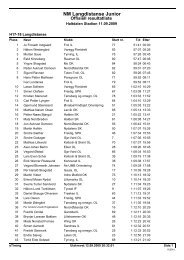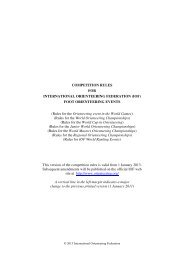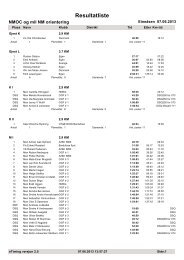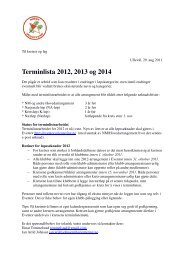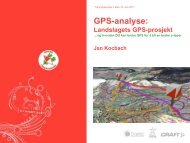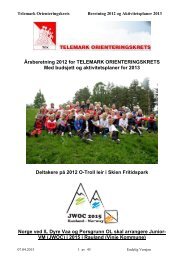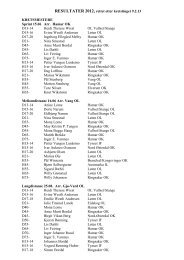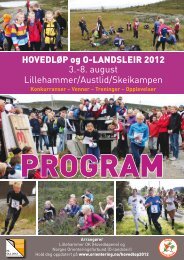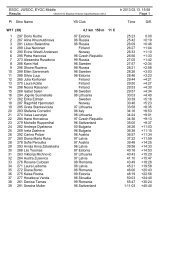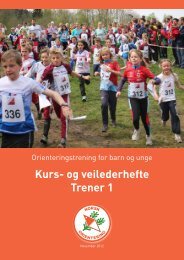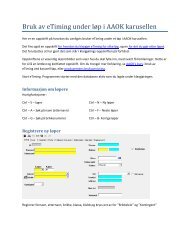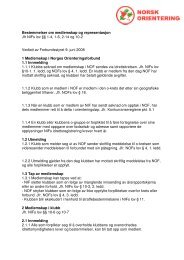International Specification for Orienteering Maps
International Specification for Orienteering Maps
International Specification for Orienteering Maps
Create successful ePaper yourself
Turn your PDF publications into a flip-book with our unique Google optimized e-Paper software.
5 MAP SPECIFICATION FOR SKI-ORIENTEERING5.1 General<strong>Maps</strong> <strong>for</strong> ski orienteering are based on the specifications <strong>for</strong> foot-orienteering maps. However in order to meetthe specific requirements put on the map by the nature of ski orienteering, certain deviations and additions to thefoot-orienteering map specification is needed. These special rules and symbols are described in this chapter.Deviations from the specifications are permissible only with the sanction of the national Ski-O Committee. Forinternational events, sanction must be given by the IOF Ski-O Committee.Complete foot-orienteering maps may be used in ski-o competitions at all levels, if the dark green (symbol 410) isreplaced by light green (symbol 406). For international events, permission from the IOF Ski-O Committee isrequired.5.2 ContentSki orienteering is a sport in which the ski-orienteer uses the map to navigate a track and route network in orderto visit a number of control points. In ski-o the competitor's skiing and navigation skills shall be tested in such waythat the navigation skill becomes the decisive element.Ski orienteering takes place in the track network, and involves as a basic element complex route choice problems,including the estimating of height differences. It is obvious that the map must concentrate on clearlydepicting these features. The map must also be legible when skiing at high speed. This means that the mapshould omit a large part of details in “free“ terrain in order to exaggerate the track network and to simplify thepresentation of the shape of the ground. Only details that impact a) route choice and b) navigation and positioning,need be shown on the map.In order to accomplish fairness in route choice, additional symbols need to be introduced. These symbolsdescribe the quality and width of the tracks.5.3 ScaleThe maps scale shall be 1:15 000 or 1:10 000. A different scale may be used, but permission shall be obtainedfrom the IOF Ski-O Committee at IOF ski-o events and from the national Ski-O Committee <strong>for</strong> other events.The magnification in scale has made it possible to build a more dense and easily legible track network.Furthermore, the error probability has decreased, as the shapes of the junctions and the departure angles of thetracks can be drawn correctly on the map.5.4 Contour intervalThe contour interval is 5 m. A different interval (2.5 m or 10 m) may be used, but permission shall be obtainedfrom the IOF Ski-O Committee at IOF ski-o events and from the national Ski-O Committee <strong>for</strong> other events.5.5 Printing and reproductionSki-orienteering maps are often updated very close to a competition. The track network may be revised only afew days be<strong>for</strong>e an event. There<strong>for</strong>e new printing methods, like digital offset, colour copying etc. is well suited <strong>for</strong>23ski-orienteering maps. However, <strong>for</strong> IOF events such as World Championships and World Cup, spot colouroffset is still the recommended method.When using alternative printing methods, it is important to make sure that the overprint effect between green andblack is maintained. The rule is that when overprinting a green track on a black path, the path must be visiblethrough the green, and not totally cleared out. When printing offset, green is the last colour ("overprint") and thiseffect is automatically achieved, but when using digital methods this effect must be controlled through thesoftware.Please refer also to section 3.4 Printing, in this publication.5.6 Recommended symbols5.6.1 Use of foot-o symbolsThe following symbols from the foot-orienteering map specification are recommended <strong>for</strong> the ski orienteeringmap.Land <strong>for</strong>msThe shape of land is shown by means of contours. In order to maintain legibility of the map when skiing at highspeed the contour lines may be more generalised in comparison to foot-o maps. Form lines shall be omitted.101 Contour, 102 Index contour, 104 Slope line, 105 Contour value, 106 Earth bank, 109 Erosion gully, 111 Knoll,114 Depression.Rock and bouldersRocks and boulders are not likely to affect route choices, but in its prominent <strong>for</strong>ms they can serve as valuableobject <strong>for</strong> navigation and positioning. The map may show these features when they are visible to the competitorwhen the terrain is covered with snow.201 Impassable cliff, 202 Rock pillars/cliffs, 206 Boulder, 207 Large boulder, 208 Boulder field, 209 Bouldercluster.Water and marshBesides navigation and positioning, this group is important to the competitor as it facilitates the interpretation ofheight (what is " up" and what is " down") in maps with complex contouring.301 Lake, 304 Uncrossable river, 305 Crossable watercourse, 306 Crossable small watercourse, 309 Uncrossablemarsh, 310 Marsh.Open land and vegetationThe representation of vegetation is of importance to the competitor mainly <strong>for</strong> navigational purposes, but couldbe used <strong>for</strong> route choices in cases where the competitor chooses to try shortcuts in free terrain. In order not todestroy legibility of the green tracks, all vegetation screens must be drawn with the symbol 406 Forest:Slow running.401 Open land, 402 Open land with scattered trees, 403 Rough open land, 404 Rough open land with scatteredtrees, 405 Open <strong>for</strong>est, 406 Forest: slow running, 412 Orchard, 413 Vineyard, 414 Distinct cultivation boundary416 Distinct vegetation boundary, 418, 419 Special vegetation features.Man-made features501 Motorway, 502 Major road, 503 Minor road, 504 Road, 505 Vehicle track, 506 Footpath, 507 Small path (notto be seen when covered with snow), 509 Narrow ride, 515 Railway, 516 Power line, 517 Major power line, 518Tunnel, 519 Stone wall, 521 High stone wall, 522 Fence, 524 High fence, 525 Crossing point, 526 Building, 527Settlement, 529 Paved area, 532 Firing range, 534 uncrossable pipeline, 536 High tower, 540,541 Special manmadefeatures.24




